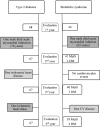Evolution of target organ damage and haemodynamic parameters over 4 years in patients with increased insulin resistance: the LOD-DIABETES prospective observational study
- PMID: 27251684
- PMCID: PMC4893862
- DOI: 10.1136/bmjopen-2015-010400
Evolution of target organ damage and haemodynamic parameters over 4 years in patients with increased insulin resistance: the LOD-DIABETES prospective observational study
Abstract
Objectives: We prospectively examined the impact of type 2 diabetes compared with metabolic syndrome (MetS) on the development of vascular disease over 4 years as determined by anatomic and functional markers of vascular disease. By comparing the vascular outcomes of the 2 disorders, we seek to determine the independent effect of elevated glucose levels on vascular disease.
Setting: 2 primary care centres in Salamanca, Spain.
Participants: We performed a prospective observational study involving 112 patients (68 with type 2 diabetes and 44 with MetS) who were followed for 4 years.
Primary and secondary outcome measures: Measurements included blood pressure, blood glucose, lipids, smoking, body mass index, waist circumference, Homeostasis Model Assessment Insulin Resistance (HOMA-IR), hs-c-reactive protein and fibrinogen levels. We also evaluated vascular, carotid intima media thickness (IMT), pulse wave velocity (PWV) and ankle/brachial index, heart and renal target organ damage (TOD). The haemodynamic parameters were central (CAIx) and peripheral (PAIx) augmentation indices.
Results: In year 4, participants with type 2 diabetes had increased IMT thickness. These patients had more plaques and an IMT>0.90 mm. In participants with MetS, we only found an increase in the number of plaques. We found no changes in PWV, CAIx and PAIx. The patients with diabetes had a greater frequency of vascular TOD. There were no differences neither in renal nor cardiac percentage of TOD in the patients with MetS or diabetes mellitus type 2.
Conclusions: This prospective study showed that the evolution of vascular TOD is different in participants with type 2 diabetes compared with those with MetS. While IMT and PWV increased in type 2 diabetes, these were not modified in MetS. The renal and cardiac TOD evolution, as well as the PAIx and CAIx, did not change in either group.
Trial registration number: NCT01065155; Results.
Keywords: Arterial stiffness; Drug treatment; Metabolic syndrome; Target organ damage; Type 2 diabetes mellitus.
Published by the BMJ Publishing Group Limited. For permission to use (where not already granted under a licence) please go to http://www.bmj.com/company/products-services/rights-and-licensing/
Figures



References
-
- Abate N, Sallam HS, Rizzo M et al. . Resistin: an inflammatory cytokine. Role in cardiovascular diseases, diabetes and the metabolic syndrome. Curr Pharm Des 2014;20:4961–9. - PubMed
Publication types
MeSH terms
Substances
Associated data
LinkOut - more resources
Full Text Sources
Other Literature Sources
Medical
Research Materials
